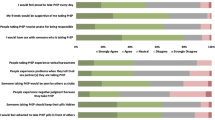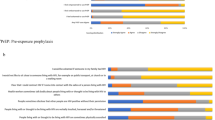Abstract
To date, there are no established scales to assess PrEP stigma among youth. We validated the Youth PrEP Stigma Scale within the Adolescent Trials Network P3 study (2019–2021). Data from sexual and gender minority youth (16–24 years) who were prescribed PrEP across nine domestic sites were evaluated (N = 235). Descriptive statistics, exploratory factor analysis, and correlation coefficients are reported. Results yielded a three-factor solution (PrEP Disapproval by Others, Enacted PrEP Stigma, and PrEP User Stereotypes) with strong factor loadings and Cronbach’s alphas ranging from 0.83 to 0.90, suggesting excellent internal consistency. Correlations between this Scale, anticipated HIV stigma, perceived HIV risk, and disclosure of sexual identity were significant, indicating potential for robust application. Given the persistence of HIV infections among youth, stigma as a barrier to prevention, and expansion of PrEP modalities, the Youth PrEP Stigma Scale could enhance intervention and mechanistic research among youth at elevated risk for HIV acquisition.
Resumen
Hasta la fecha, no existen escalas establecidas para evaluar el estigma de la PrEP entre los jóvenes. Validamos la Escala de estigma de la PrEP para jóvenes dentro del estudio P3 de la Red de ensayos para adolescentes (2019–2021). Se evaluaron los datos de jóvenes de minorías sexuales y de género (16–24 años) a quienes se les recetó PrEP en nueve sitios domésticos (N = 235). Se informan estadísticas descriptivas, análisis factorial exploratorio y coeficientes de correlación. Los resultados arrojaron una solución de tres factores (desaprobación de PrEP por parte de otros, estigma de PrEP promulgado y estereotipos de usuarios de PrEP) con fuertes cargas factoriales y alfas de Cronbach que oscilan entre 0.83 y 0.90, lo que sugiere una excelente consistencia interna. Las correlaciones entre esta Escala, el estigma anticipado del VIH, el riesgo percibido del VIH y la divulgación de la identidad sexual fueron significativas, lo que indica un potencial para una aplicación sólida. Dada la persistencia de las infecciones por el VIH entre los jóvenes, el estigma como una barrera para la prevención y la expansión de las modalidades de PrEP, la Escala de estigma de la PrEP para jóvenes podría mejorar la intervención y la investigación mecánica entre los jóvenes con un riesgo elevado de contraer el VIH.
Similar content being viewed by others
Data Availability
Data is available upon request through the University of North Carolina, Chapel Hill (UNC) BatLab via the study Principal Investigator, Dr. Lisa Hightow-Weidman.
Code Availability
Code is available upon request from our quantitative lead, Dr. İbrahim Yiğit.
References
Spinner CD, Boesecke C, Zink A, Jessen H, Stellbrink H-J, Rockstroh JK, et al. HIV pre-exposure prophylaxis (PrEP): a review of current knowledge of oral systemic HIV PrEP in humans. Infection. 2016;44(2):151–8.
Camp C, Saberi P. Facilitators and barriers of 2-1-1 HIV pre-exposure prophylaxis. PLoS ONE. 2021;16(5):e0251917.
Wood BR. Prevention of HIV for persons with low-frequency, high-risk exposures: PrEP (preexposure prophylaxis), PEP (postexposure prophylaxis), or ‘PIP’ (postexposure prophylaxis in-pocket). AIDS. 2020;34(3).
Ogunbajo A, Tsai AC, Kanki PJ, Mayer KH. Acceptability of and Preferences for Long-Acting Injectable HIV PrEP and Other PrEP Modalities among Sexual Minority Men in Nigeria, Africa. AIDS and Behavior; 2022.
Hart-Cooper GD, Allen I, Irwin CE Jr, Scott H. Adolescent Health Providers’ Willingness to Prescribe Pre-Exposure Prophylaxis (PrEP) to Youth at Risk of HIV Infection in the United States. J Adolesc Health. 2018;63(2):242–4.
Macapagal K, Kraus A, Korpak AK, Jozsa K, Moskowitz DA. PrEP Awareness. Uptake, Barriers, and Correlates Among Adolescents Assigned Male at Birth Who Have Sex with Males in the U.S. Arch Sex Behav. 2020;49(1):113–24.
Stoner MCD, Bhushan NL, Maragh-Bass AC, Mitchell JT, Riggins L, Walker M, et al. Using Participatory Methods to Assess PrEP Interest and Uptake Among Young People Living in the Southeastern US: A Mixed Methods Assessment. AIDS Behav. 2021.
Biello KB, Hosek S, Drucker MT, Belzer M, Mimiaga MJ, Marrow E, et al. Preferences for Injectable PrEP Among Young U.S. Cisgender Men and Transgender Women and Men Who Have Sex with Men. Arch Sex Behav. 2018;47(7):2101–7.
Dévieux J, Malow R, Stein JA, Jennings TE, Lucenko BA, Averhart C, et al. Impulsivity and HIV risk among adjudicated alcohol- and other drug-abusing adolescent offenders. AIDS Educ Prev. 2002;14(5 Suppl B):24–35.
Kovensky R, Khurana A, Guyer S, Leve LD. Childhood Adversity, Impulsivity, and HIV Knowledge as Predictors of Sexual Risk Outcomes in At-Risk Female Youth. Adolescents. 2021;1(1):56–69.
Budhwani H, Naar S. Training Providers in Motivational Interviewing to Promote Behavior Change Pediatric Clinics of North America. In press.
Ogunbajo A, Storholm ED, Ober AJ, Bogart LM, Reback CJ, Flynn R, et al. Multilevel Barriers to HIV PrEP Uptake and Adherence Among Black and Hispanic/Latinx Transgender Women in Southern California. AIDS Behav. 2021;25(7):2301–15.
Pinto RM, Berringer KR, Melendez R, Mmeje O. Improving PrEP Implementation Through Multilevel Interventions: A Synthesis of the Literature. AIDS Behav. 2018;22(11):3681–91.
Turan JM, Elafros MA, Logie CH, Banik S, Turan B, Crockett KB, et al. Challenges and opportunities in examining and addressing intersectional stigma and health. BMC Med. 2019;17(1):7.
Budhwani H, Robles G, Starks TJ, MacDonell KK, Dinaj V, Naar S. Healthy Choices Intervention is Associated with Reductions in Stigma Among Youth Living with HIV in the United States (ATN 129). AIDS Behav. 2021;25(4):1094–102.
Quinn K, Bowleg L, Dickson-Gomez J. “The fear of being Black plus the fear of being gay”: The effects of intersectional stigma on PrEP use among young Black gay, bisexual, and other men who have sex with men. Soc Sci Med. 2019;232:86–93.
Goffman E. Selections from stigma. The disability studies reader. 1997;203:215.
Turan B, Budhwani H, Fazeli PL, Browning WR, Raper JL, Mugavero MJ, et al. How Does Stigma Affect People Living with HIV? The Mediating Roles of Internalized and Anticipated HIV Stigma in the Effects of Perceived Community Stigma on Health and Psychosocial Outcomes. AIDS Behav. 2017;21(1):283–91.
Budhwani H, De P. Perceived Stigma in Health Care Settings and the Physical and Mental Health of People of Color in the United States. Health Equity. 2019;3(1):73–80.
Crenshaw KW. On intersectionality: Essential writings. The New Press; 2017.
Logie CH, James L, Tharao W, Loutfy MR. HIV, gender, race, sexual orientation, and sex work: a qualitative study of intersectional stigma experienced by HIV-positive women in Ontario, Canada. PLoS Med. 2011;8(11):e1001124.
Earnshaw VA, Smith LR, Cunningham CO, Copenhaver MM. Intersectionality of internalized HIV stigma and internalized substance use stigma: Implications for depressive symptoms. J Health Psychol. 2015;20(8):1083–9.
Mulawa MI, Rosengren AL, Amico KR, Hightow-Weidman LB, Muessig KE. mHealth to reduce HIV-related stigma among youth in the United States: a scoping review. Mhealth. 2021;7:35-.
Wood S, Gross R, Shea JA, Bauermeister JA, Franklin J, Petsis D, et al. Barriers and Facilitators of PrEP Adherence for Young Men and Transgender Women of Color. AIDS Behav. 2019;23(10):2719–29.
Allan-Blitz LT, Mena LA, Mayer KH. The ongoing HIV epidemic in American youth: challenges and opportunities. Mhealth. 2021;7:33.
Rosengren AL, Lelutiu-Weinberger C, Woodhouse EW, Sandanapitchai P, Hightow-Weidman LB. A Scoping Review of HIV Pre-exposure Prophylaxis Stigma and Implications for Stigma-Reduction Interventions for Men and Transwomen Who Have Sex with Men. AIDS Behav. 2021;25(7):2054–70.
Golub SA. PrEP Stigma: Implicit and Explicit Drivers of Disparity. Curr HIV/AIDS Rep. 2018;15(2):190–7.
Tangmunkongvorakul A, Chariyalertsak S, Amico KR, Saokhieo P, Wannalak V, Sangangamsakun T, et al. Facilitators and barriers to medication adherence in an HIV prevention study among men who have sex with men in the iPrEx study in Chiang Mai, Thailand. AIDS Care. 2013;25(8):961–7.
Budhwani H, Kiszla MB, Hightow-Weidman LB. Adapting Digital Health Interventions for the Evolving HIV Landscape: Examples to Support Prevention and Treatment Research. Current Opinion in HIV and AIDS. In press.
Klein H, Washington TA. The Pre-Exposure Prophylaxis (PrEP) Stigma Scale: Preliminary findings from a pilot study. Int Public Health J. 2019;11(2):185–95.
Siegler AJ, Wiatrek S, Mouhanna F, Amico KR, Dominguez K, Jones J, et al. Validation of the HIV Pre-exposure Prophylaxis Stigma Scale: Performance of Likert and Semantic Differential Scale Versions. AIDS Behav. 2020;24(9):2637–49.
Algarin AB, Hee Shrader C, Hackworth BT, Varas-Diaz N, Fennie KP, Sheehan DM, et al. Development and Validation of the Community PrEP-Related Stigma Scale (Community-PSS). AIDS Educ Prev. 2021;33(2):120–8.
Calabrese SK, Dovidio JF, Tekeste M, Taggart T, Galvao RW, Safon CB, et al. HIV Pre-Exposure Prophylaxis Stigma as a Multidimensional Barrier to Uptake Among Women Who Attend Planned Parenthood. J Acquir Immune Defic Syndr. 2018;79(1):46–53.
LeGrand S, Knudtson K, Benkeser D, Muessig K, McGee A, Sullivan PS, et al. Testing the Efficacy of a Social Networking Gamification App to Improve Pre-Exposure Prophylaxis Adherence (P3: Prepared, Protected, emPowered): Protocol for a Randomized Controlled Trial. JMIR Res Protoc. 2018;7(12):e10448-e.
Golub SA, Gamarel KE, Surace A. Demographic Differences in PrEP-Related Stereotypes: Implications for Implementation. AIDS Behav. 2017;21(5):1229–35.
Tabachnick BG, Fidell LS. Cleaning up your act: Screening data prior to analysis. Using Multivar Stat. 2001;5:61–116.
Golub SA, Gamarel KE. The Impact of Anticipated HIV Stigma on Delays in HIV Testing Behaviors: Findings from a Community-Based Sample of Men Who Have Sex with Men and Transgender Women in New York City. AIDS Patient Care STDs. 2013;27(11):621–7.
Napper LE, Fisher DG, Reynolds GL. Development of the perceived risk of HIV scale. AIDS Behav. 2012;16(4):1075–83.
Bouris A, Guilamo-Ramos V, Pickard A, Shiu C, Loosier PS, Dittus P, et al. A systematic review of parental influences on the health and well-being of lesbian, gay, and bisexual youth: time for a new public health research and practice agenda. J Prim Prev. 2010;31(5–6):273–309.
Ryan C, Russell ST, Huebner D, Diaz R, Sanchez J. Family acceptance in adolescence and the health of LGBT young adults. J Child Adolesc Psychiatr Nurs. 2010;23(4):205–13.
Thompson B, Daniel LG. Factor Analytic Evidence for the Construct Validity of Scores: A Historical Overview and Some Guidelines. Educ Psychol Meas. 1996;56(2):197–208.
Velicer WF, Eaton CA, Fava JL. Construct explication through factor or component analysis: A review and evaluation of alternative procedures for determining the number of factors or components. Problems and solutions in human assessment. 2000:41–71.
Kaiser HF. A note on Guttman’s lower bound for the number of common factors. Br J Stat Psychol. 1961;14:1–2.
Kalichman SC, Shkembi B, Eaton LA. Finding the Right Angle: A Geometric Approach to Measuring Intersectional HIV Stigma. AIDS Behav. 2022;26(1):27–38.
Funding
Research reported in this publication was supported by the National Institute of Mental Health (NIMH) and the Eunice Kennedy Shriver National Institute of Child Health and Human Development (NICHD) of the National Institutes of Health (NIH) under Award Numbers K01MH116737 and R25MH067127 (Budhwani) and U19HD089881 (Hightow-Weidman). The content is solely the responsibility of the authors and does not necessarily represent the official views of the NIH.
Author information
Authors and Affiliations
Contributions
LHW is the senior author and parent study Principal Investigator. HB is the lead author. LHW and HB jointly conceptualized the study in consultation with AMB and KEM. IY conducted all quantitative analyses. All authors contributed to the writing and revising of this manuscript.
Corresponding author
Ethics declarations
Conflict of Interest
None noted.
Ethics Approval
The Adolescent Medicine Trials Network for HIV/AIDS Interventions (ATN) Prepared, Protected, emPowered (P3: ATN protocol 142) informed assent/consent documents, and related modifications were reviewed and approved by the University of North Carolina, Chapel Hill (UNC) Institutional Review Board (IRB, #17-1951).
Consent to Participate
All participants agreed to participate and provided informed consent.
Consent for Publication
Not applicable.
Additional information
Publisher’s Note
Springer Nature remains neutral with regard to jurisdictional claims in published maps and institutional affiliations.
Rights and permissions
Springer Nature or its licensor holds exclusive rights to this article under a publishing agreement with the author(s) or other rightsholder(s); author self-archiving of the accepted manuscript version of this article is solely governed by the terms of such publishing agreement and applicable law.
About this article
Cite this article
Budhwani, H., Yiğit, İ., Maragh-Bass, A.C. et al. Development and Validation of the Youth Pre-Exposure Prophylaxis (PrEP) Stigma Scale. AIDS Behav 27, 929–938 (2023). https://doi.org/10.1007/s10461-022-03829-9
Accepted:
Published:
Issue Date:
DOI: https://doi.org/10.1007/s10461-022-03829-9




